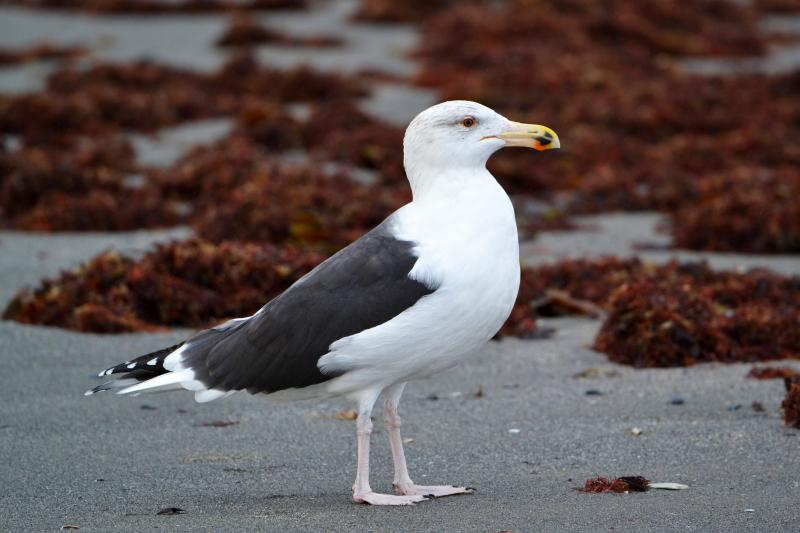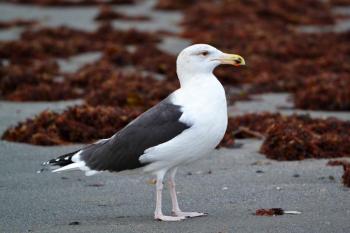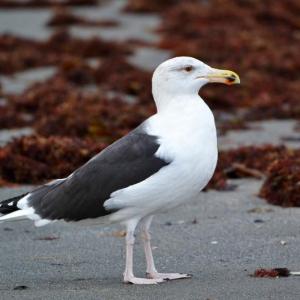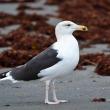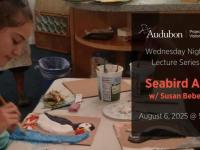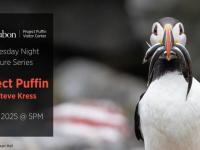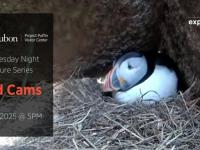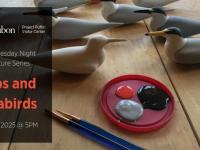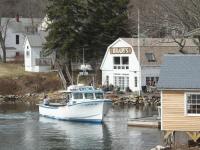Maine’s True “Sea Gull”
We wrote a few weeks ago about gulls, especially highlighting the herring gull, a large, gray-backed gull with black wingtips and a yellow bill that the uninitiated often think of as the typical “sea gull.” Herring gulls are common across the large expanse of northern inland North America in summer and in much of the inland U.S and southern Canada during migration and winter. Thus it is not particularly accurate to call them a gull of the sea! But there is another large gull that nests in Maine that could claim the nickname, “sea gull.”
That bird is the largest gull species in the world, the great black-backed gull.
The scientific name of the great black-backed gull, Larus marinus, suggests the bird’s marine tendencies were long known. Great black-backed gulls almost never nest away from the coast and become less and less common the farther inland you go. They also seem less prone to southern wandering then herring gulls. When we wrote our book, The Birds of Aruba, Bonaire, and Curacao, we noted that there were only three records of great black-backed gull but six of herring gull from these islands just off the Venezuelan coast. A scan of eBird records also shows many more herring gull vagrants across the Caribbean and into northern South America and no great black-backed gull records south of Aruba.
Great black-backed gulls have always enjoyed a northern coastal distribution on both sides of the Atlantic. We particularly love some of the names said to have been bestowed on the species by the people of coastal Newfoundland where the birds have always been common. Among the names Newfoundlanders have used for them are “saddleback,” “minister” (presumably highlighting the very contrasting black back) and “turkey gull.” Perhaps the latter name is because of its large size? And we assume that the name “coffin-bearer” must also have been in reference to the adult’s crisp black-and-white appearance, like a person wearing their black coat and pants and white shirt to a funeral. If not that then those Newfies had some spooky ideas about these birds!
Like herring gulls, great black-backed gulls were apparently heavily impacted by the taking of eggs, and presumably shooting of adults as well, around nesting colonies in the years prior to 1900. Others have suggested that the sea mink, a mammal that became extinct in the 1800s and that roamed the Maine coast, may have been a regular egg predator that kept gulls and other seabirds off of at least nearshore islands.
In any case there were no great black-backed gulls proven to have nested south of Canada until about 1930. Amazingly their numbers had ballooned to more than 1,000 nesting pairs in Maine by 1944. Numbers just kept growing, reaching a maximum of 16,400 pairs in the mid-1990s. The largest colony documented on the Maine coast was of 1,343 pairs on Smuttynose Island in York County in 1989 although our own Damariscove Island was estimated to have hosted more than 800 nesting pairs in 2008.
Since those peak numbers in the 1990s, great black-backed gulls, like herring gulls, have greatly declined. In 2008, nesting numbers were almost halved to 9,500 pairs. As we mentioned in our earlier gull column, this decline is thought to be because of the closure of large numbers of open landfills and the decline of many commercial fisheries, both of which provided vast amounts of food for scavenging gulls.
A curious observation about great black-backed gulls is that their nesting population here in Maine has been about a third the size of the herring gull nesting population for decades, but in winter, they make up only about a tenth of the large gull population. Our guess is that this is because of the winter influx of large numbers of herring gulls that breed across northern Canada but migrate south in winter.
Jeffrey V. Wells, Ph.D., is a Fellow of the Cornell Lab of Ornithology. Dr. Wells is one of the nation's leading bird experts and conservation biologists and author of “Birder’s Conservation Handbook”. His grandfather, the late John Chase, was a columnist for the Boothbay Register for many years. Allison Childs Wells, formerly of the Cornell Lab of Ornithology, is a senior director at the Natural Resources Council of Maine, a nonprofit membership organization working statewide to protect the nature of Maine. Both are widely published natural history writers and are the authors of the book, “Maine’s Favorite Birds” and the newly published “Birds of Aruba, Bonaire, and Curaçao” from Cornell Press.
Event Date
Address
United States

